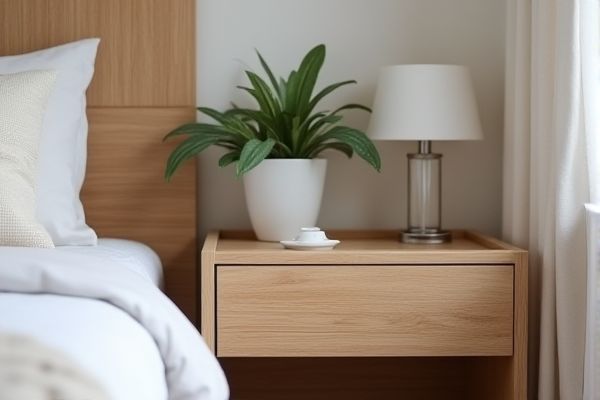
Choosing between a bed tray and a nightstand caddy depends on your need for portability versus fixed storage; a bed tray offers a flat surface for meals or work while lounging, whereas a nightstand caddy provides organized compartments to keep essentials within arm's reach. Explore the article to discover which option best suits your lifestyle and complement your bedroom setup.
Table of Comparison
| Feature | Bed Tray | Nightstand Caddy |
|---|---|---|
| Primary Use | Portable surface for meals, laptops, or reading in bed | Organizational storage attached to nightstand or bed frame |
| Portability | Highly portable and movable | Fixed or semi-fixed, less portable |
| Storage Capacity | Limited to tray surface area | Multiple pockets and compartments for personal items |
| Material | Wood, plastic, metal commonly used | Fabric or mesh materials |
| Setup | Requires manual placement each use | Attaches permanently or semi-permanently to furniture |
| Best For | Temporary use such as meals or working in bed | Long-term bedside organization and easy access to items |
Introduction: Bed Tray vs Nightstand Caddy
A bed tray offers a stable, flat surface ideal for meals, laptops, or reading materials, enhancing convenience during bed rest or relaxation. Nightstand caddies maximize bedside organization by providing multiple compartments for essentials like remotes, glasses, and books, ensuring easy access without clutter. Both solutions cater to different needs: the bed tray emphasizes portability and usability for active tasks, while the nightstand caddy focuses on storage and space-saving.
Key Differences Between Bed Trays and Nightstand Caddies
Bed trays provide a stable, flat surface typically used for meals, laptops, or writing while in bed, featuring foldable legs for portability and ease of storage. Nightstand caddies are soft-sided organizers designed to hang on the side of a bed or nightstand, offering compartments to store books, remotes, glasses, and other personal items within easy reach. The primary difference lies in functionality: bed trays serve as work or dining surfaces, whereas nightstand caddies function as accessible storage solutions for bedside essentials.
Design and Functionality Comparison
Bed trays offer a flat, portable surface ideal for meals or laptops, featuring foldable legs for easy storage and mobility. Nightstand caddies provide organized storage with multiple pockets and compartments, designed to attach securely to your bed frame, keeping essentials within reach. Choosing between them depends on whether you prioritize a versatile workspace or accessible bedside organization for Your convenience.
Space-Saving Benefits
Bed trays offer a compact, foldable design that maximizes space by easily tucking away when not in use, ideal for small bedrooms or apartments. Nightstand caddies attach to the side of the bed, providing organized storage for essentials without occupying floor or surface space. Both solutions enhance bedroom efficiency by reducing clutter and optimizing available space.
Materials and Durability
Bed trays often feature wooden or plastic surfaces with foldable metal legs, offering sturdy support and moderate durability suitable for daily use. Nightstand caddies are typically made from fabric, mesh, or synthetic materials with reinforced stitching, designed for lightweight and flexible storage but may wear out faster under heavy use. Choosing between the two depends on desired longevity and material preference, with bed trays excelling in solid durability and nightstand caddies favoring portability.
Ease of Accessibility
A bed tray offers immediate accessibility by providing a flat surface right over your lap, ideal for meals or working in bed without leaving your space. Nightstand caddies keep essentials organized within arm's reach, perfect for keeping books, glasses, or remote controls nearby during rest. Your choice depends on whether you prioritize a stable, portable surface or a stationary storage solution for ease of accessibility.
Ideal Uses in Bedroom Settings
A bed tray is ideal for serving meals, working on a laptop, or reading comfortably while in bed, making it perfect for breakfast in bed or focused tasks. A nightstand caddy excels at organizing essential items like books, glasses, phones, and remote controls within easy reach, enhancing bedroom tidiness and convenience. Your choice depends on whether you need a portable surface or practical storage solution near your bed.
Pros and Cons of Bed Trays
Bed trays offer portability and convenience, allowing you to enjoy meals, laptops, or reading materials comfortably in bed, which is perfect for those with limited mobility or recovering from illness. However, their limited surface area and lack of storage compartments can make organization difficult, and they may be less stable compared to nightstand caddies, increasing the risk of spills. You benefit from easy-to-clean surfaces, but the bed tray's fixed size might not accommodate larger or multiple items efficiently.
Pros and Cons of Nightstand Caddies
Nightstand caddies offer organized storage for essentials like phones, glasses, and books, keeping items within easy reach and reducing bedroom clutter. They maximize vertical space, often featuring multiple pockets, but their fixed position limits mobility compared to portable options like bed trays. A key downside is potential obstruction of bedside drawers or outlets, requiring careful placement to avoid inconvenience.
Choosing the Right Option for Your Needs
Bed trays offer a stable, flat surface ideal for meals or laptop use in bed, prioritizing portability and easy storage. Nightstand caddies provide organized storage for essentials like remotes, books, and glasses, attaching securely to your bed frame or nightstand to save space. Selecting between a bed tray and a nightstand caddy depends on whether you need a flexible eating surface or hands-free, accessible storage by your bedside.
 homyna.com
homyna.com